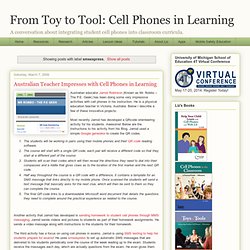

New Study Uncovers If Texting Actually Affects Grammar. If you’re worried that your students or children are eroding their vocabulary due to texting, you may want to sit down. Thanks to a new study in New Media & Society , it appears that students who text on a frequent basis perform worse on grammar tests. The study examined sixth, seventh, and eighth graders in Pennsylvania. S. Shyam Sundar, who supervised the study, says the reason students perform worse on grammar tests is because texting is not actually a different language. It therefore works its way into the classroom , homework, and all facets of language. Cell Phones in Learning: smsexpress. Australian educator Jarrod Robinson (Known as Mr.

Robbo -- The P.E. Geek) has been doing some very impressive activities with cell phones in his instruction. He is a physical education teacher in Victoria, Australia. From Toy to Tool: Cell Phones in Learning. Back to School with New Devices? Lesson #1: Mobile Safety - Microsoft on the Issues. Posted by Jacqueline BeauchereDirector, Trustworthy Computing Communications, Microsoft Unlike their parents who went back to school with new notebooks, pens, pencils, and binders, today’s young people are likely readying for the coming academic year with laptops, tablets and mobile phones.

But, before parents arm kids with the latest Internet-enabled devices, it’s a good idea to share some do’s and don’ts about online safety. Whether it’s a new laptop for research and writing, a tablet for reading, or a mobile phone to get in touch with mom or dad in the event of an emergency, kids are using mobile technology more than ever. Data show that 52 percent of kids ages eight to 12, and 77 percent between 12 and 17, own mobile phones, with teenagers 14 to 17 sending an average of 100 text messages a day. When it comes to Internet safety, some practical advice can go a long way toward helping kids stay safer and more secure when they’re online on the go.
Coolcatteacher.blogspot.com/2009/03/making-case-for-cell-phones-in-schools.html. My husband and BFF, Kip, has been with me on the last leg of my trip to the amazingly incredible CUE conference in Palm Springs (NCTIES before that.)

We're now in Salt Lake City for a two hour layover and he's TRYING to read the latest Tom Clancy book. He is director of engineering of a manufacturing plant and has a genius mind for efficiency, managing people, AND making technology UNDERSTANDABLE to the average person. So, I asked him, "What is the most important point that you heard at the CUE conference? " The history of the cell phones for learning movement. Cell phones and the technologies they provide for educational enhancements, especially text messaging, will be so obvious that school policy allowing them within classrooms and for educational purposes will begin to be adopted throughout the country.

Gartner Inc, a Connecticut-based technology research and advisory firm, predicts that by 2010, 70 percent of residents in developed nations will spend 10 times longer per day interacting with people in the e-world than the physical one. (Dunewind, 2003). Additionally, “The only difference now between smartphones and laptops, they say, is that cellphones are smaller, cheaper, and more coveted by students” (Richtel & Stone, 2009). As cell phone technologies continue to improve, become more available, and have more computer connections, their use as educational tools will continue to grow. Teaching Generation Text: Using Cell Phones to Enhance Learning. Mobilizing the power of cell phones to maximize students' learning power Teaching Generation Text shows how teachers can turn cell phones into an educational opportunity instead of an annoying distraction.

With a host of innovative ideas, activities, lessons, and strategies, Nielsen and Webb offer a unique way to use students' preferred method of communication in the classroom. Cell phones can remind students to study, serve as a way to take notes, provide instant, on-demand answers and research, be a great vehicle for home-school connection, and record and capture oral reports or responses to polls and quizzes, all of which can be used to enhance lesson plans and increase motivation. How an innovative educator became interested in mobile devices for learning. Media.wiley.com/product_data/excerpt/77/11180768/1118076877-180.pdf. Cell Phones. Hot Topics > Cell Phones Copyright Microsoft Clipart.

Creating a plan with students to use cell phones for learning. Respond to the Naysayers with these Answers to FAQs about Using Cell Phones for Learning. 10 Reasons Cell Phones Should Be Allowed In Schools. Vicki Davis shares 10 reasons cell phones should be allowed in schools.

Visit Making the Case for Cell Phones in Schools for a description and details around each of the reasons below. Here is a recap of the list. Ten reasons to get off the cell phone ban wagon. 6 Ways to Use Cell Phones to Strengthen the Home-School Connection. 10 Proven Strategies to Break the Ban and Build Opportunities for Student Learning with Cell Phones. 6 Ideas for Administrators Who Want to Lead the Way to Texting for Success. Group Texting As instructional leader and manager of the school organization Principals must engage in ongoing communication with staff, parents, and the community.

Group texting is a free tool that saves time and enhances communication. By collecting the cell phone numbers of students, staff, parents, and community stakeholders and setting them up in a group text service, a principal can easily reach the masses with one text message. Kurt Clay, Principal of Delta High School, knows this first hand.
5 Reasons to Allow Students to Use Cell Phones in Class. This morning, a discussion between members of my PLN on Plurk got me thinking about rules in school that ban cell phone usage.

In today's post I'm going to explore five reasons why banning cell phones in schools is bad policy and detrimental for our students. If we are preparing our students for life after school, we should allow them to use the tools they will be using when they get there. How many jobs can you think of right now where a smart phone is not beneficial? Mechanics order parts on their phone, engineers view blueprints, doctors calculate dosages, and grocers check inventory. The list is endless. For those who have read the Harry Potter books or seen the movies, a member of my PLN showed drew a great parallel between events in those stories and this debate with the following quote: "Children, put away your wands. Now it's your turn. The 60-Second Guide To Smartphones In Education. Smartphones and apps are the pinnacle of buzzwords when it comes to education. You can’t swing an app without hitting a smartphone…or something.
So what’s all the buzz about? Are smartphones really that big a deal in education? Let’s examine the facts: 15 Surprising Things You May Not Know About Texting. Should You Text Your Students? If you’re a higher ed administrator, teacher, or even student organizer then there’s something you should know. If you plan on reaching students and getting your message across then you may want to try texting and not rely on e-mail. However, there are privacy concerns with texting as you may want to have an opt-in strategy and not just start spamming your students. A new Ball State University study says text messaging has far eclipsed e-mail and instant messaging as college students’ favored way of staying in touch.
The findings show that 97 percent of students now send and receive text messages , while only about a quarter of them use e-mail or instant messaging. Ball State journalism professor Michael Hanley also found that smart phones now account for 49 percent of mobile communication devices on college campuses. He says that except for studying, students are quickly leaving computers and e-mail behind. What do you think? However, there are two big concerns. 11 Real Ways Technology Is Affecting Education Right Now. How Online Education Has Changed In 10 Years 8.44K Views 0 Likes We all know that education, specifically online education, has come a long way in the last few years.

We've already taken a look back - way back - at online education as we rarely think of it (in the 1960's and 70's), but it is also interesting to see just how much online education has evolved in just the more recent past. Why TED Talks Have Become So Popular 6.89K Views 0 Likes. Cartoon.jpg (554×554) COMIC: Will Texting Replace Raising Your Hand In Class?
Algebra: In Your Face! 4.94K Views 0 Likes What happened when you graduated from high school? Or college? Did you basically forget 90% of what you learned? Looking back, do you only remember who your teacher was and not what they taught you? New Web App Gamifies Your Classroom With Text Messages 4.28K Views 0 Likes When you hear the term 'texting' you probably cringe a bit. Educators Use Mobile Devices More Than General Public - Digital Education. Europe Seen Leading the Way in Hand-Held Computing. Published Online: January 30, 2012. The 60-Second Guide To Smartphones In Education. Smartphones and apps are the pinnacle of buzzwords when it comes to education. You can’t swing an app without hitting a smartphone…or something. So what’s all the buzz about? Is the Cell Phone the New Pencil? It is commonplace to bemoan the poor writing skills of students today. Yes, there is no question that writing effectively is difficult.
Yes, it is true that we don't provide enough high quality writing instruction (writing is known as the "forgotten R"). Educators Use Mobile Devices More Than General Public - Digital Education. Districts Tackle Questions Surrounding BYOT Policy. School Administrators Seen to Embrace New Digital Devices. Students Turn Their Cellphones On for Classroom Lessons. Europe Seen Leading the Way in Hand-Held Computing. Making the Case for Mobile Tech. Expansion. The New Digital Divide - Coach G's Teaching Tips. Tweeting. Texting. Messaging. Friending. Skyping.
My Student Network: An Innovative Use of Text Messaging. Cell phones in the classroom: It’s the law. Texting in the Classroom: Not Just a Distraction. The Pew Research Center released new data this week on Americans' text-messaging habits.